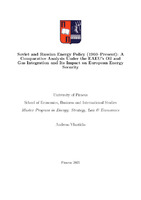| dc.description.abstractEN | This thesis presents a comprehensive comparative analysis of the Soviet Union’s energy policies between 1960 and 1990 and Russia’s energy strategies from 2000 to the present day. Framed within the context of the Eurasian Economic Union’s (EAEU) regional oil and gas integration initiative, the study evaluates the consistencies and divergences between these two eras while exploring their implications for Europe’s energy security. By employing a mixed-methodology approach, the thesis integrates bibliographic data and applies Event Tree Analysis to examine critical scenarios in energy geopolitics. The research identifies key themes in Soviet energy policy, including centralized planning, heavy investments in oil and gas production, and the strategic use of energy exports to support geopolitical objectives. These historical trends contrast with Russia’s post-2000 strategies, which emphasize market-oriented reforms, export expansion, and the use of energy resources as a tool of geopolitical influence, which even reaches the field of cybersecurity and the cyber dimension of energy politics. The study further analyzes the evolution of European energy security, particularly in the wake of recent geopolitical developments such as the war in Ukraine, the European Union’s diversification efforts, and sanctions against Russia. Key findings highlight how Russia inherited and adapted Soviet energy strategies while navigating a shifting geopolitical and economic landscape. The thesis also explores the EAEU’s energy integration efforts and their potential to shape regional energy markets. The study concludes that contemporary energy relations between Russia and Europe are increasingly defined by mutual dependencies, rising tensions, and a growing emphasis on renewable energy transition within the EU. This research contributes to the broader understanding of energy geopolitics by offering a nuanced historical and contemporary perspective. It underscores the critical need for diversified energy strategies, greater collaboration among regional players, and a more sustainable energy future for Europe. | el |



